tow Lexus GX470 2008 Operating the lights and windshield wipers / LEXUS 2008 GX470 (OM60D82U) Service Manual
[x] Cancel search | Manufacturer: LEXUS, Model Year: 2008, Model line: GX470, Model: Lexus GX470 2008Pages: 458, PDF Size: 7.3 MB
Page 371 of 458

When trouble arises5
371
5-1. Essential information .... 372If your vehicle needs to be towed ...................................... 372
If you think something is wrong ....................................... 377
Fuel pump shut off system ... 378
Event data recorder.............. 379
5-2. Steps to take in an emergency .................... 381
If a warning light turns on or a warning buzzer sounds... ... 381
If you have a flat tire................ 391
If the engine will not start .... 402
If the shift lever cannot be shifted from P ....................... 403
If you lose your keys .............. 404
If the vehicle battery is discharged ............................ 405
If your vehicle overheats ..... 408
If the vehicle becomes stuck......................................... 410
Page 372 of 458
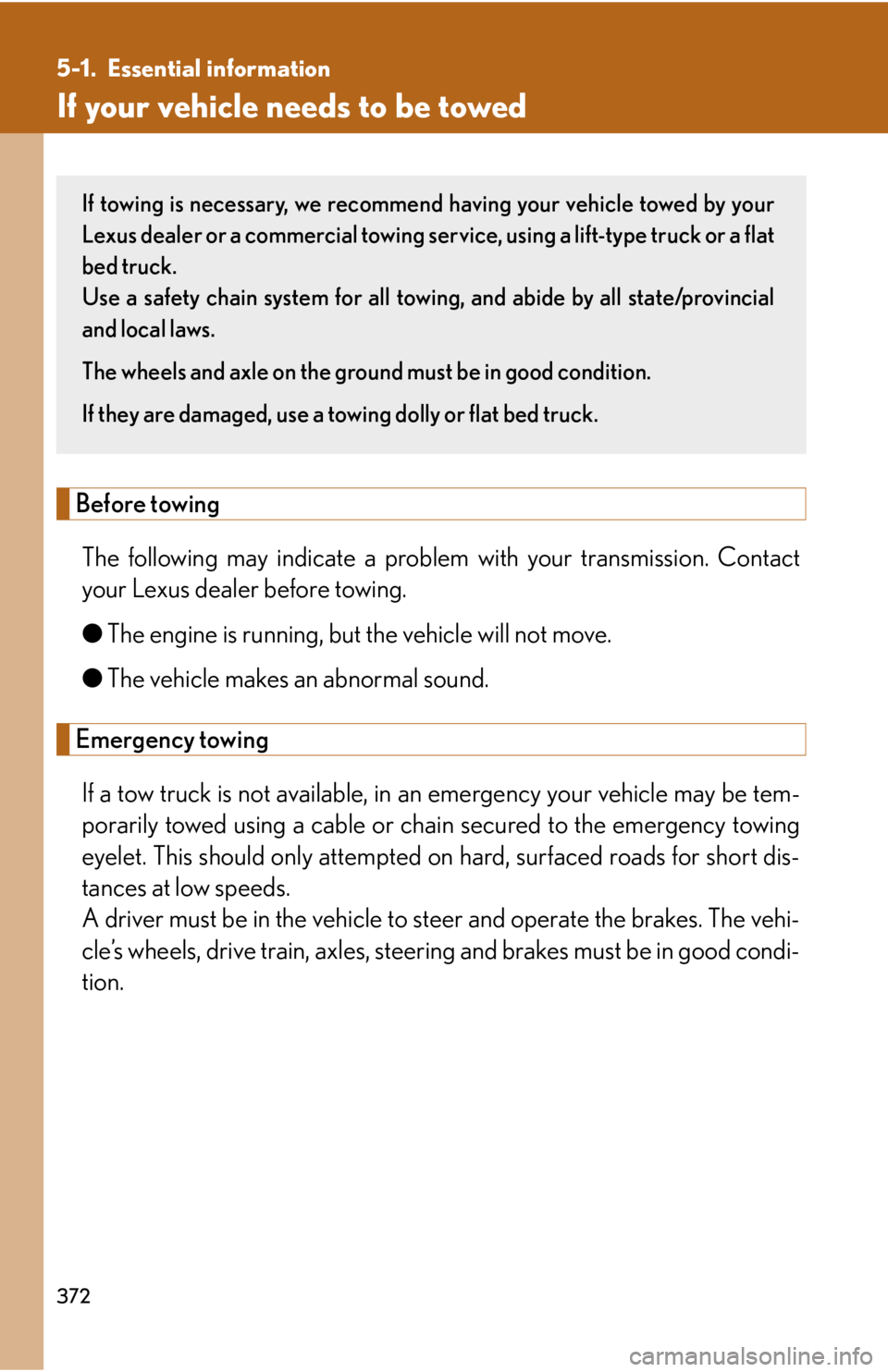
372
5-1. Essential information
If your vehicle needs to be towed
Before towingThe following may indicate a problem with your transmission. Contact
your Lexus dealer before towing.
● The engine is running, but the vehicle will not move.
● The vehicle makes an abnormal sound.
Emergency towing
If a tow truck is not available, in an emergency your vehicle may be tem-
porarily towed using a cable or chain secured to the emergency towing
eyelet. This should only attempted on hard, surfaced roads for short dis-
tances at low speeds.
A driver must be in the vehicle to s teer and operate the brakes. The vehi-
cle’s wheels, drive train, axles, steering and brakes must be in good condi-
tion.
If towing is necessary, we recommend having your vehicle towed by your
Lexus dealer or a commercial towing se rvice, using a lift-type truck or a flat
bed truck.
Use a safety chain system for all towi ng, and abide by all state/provincial
and local laws.
The wheels and axle on the ground must be in good condition.
If they are damaged, use a to wing dolly or flat bed truck.
Page 373 of 458
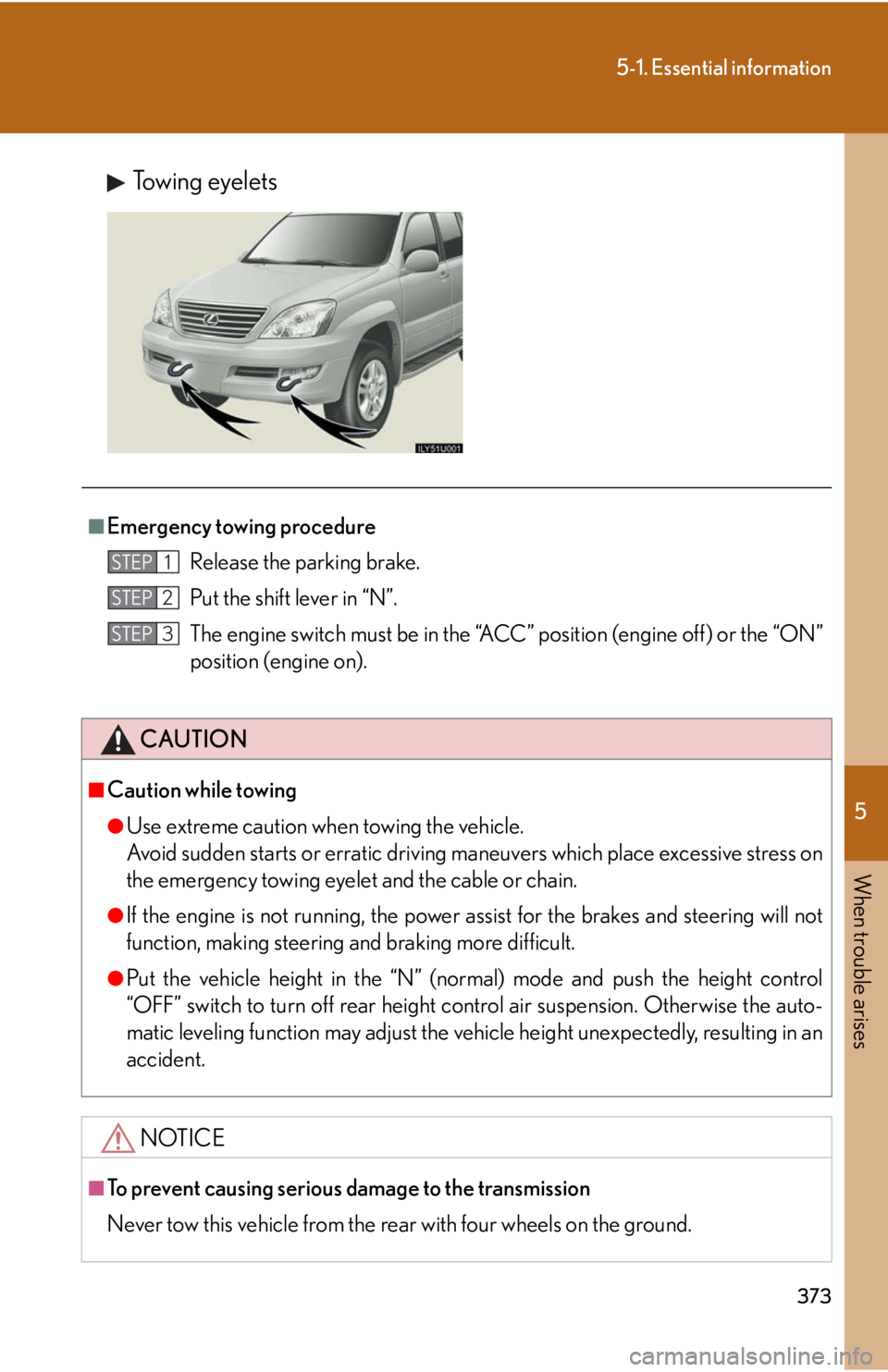
5
When trouble arises
373
5-1. Essential information
Towing eyelets
■Emergency towing procedureRelease the parking brake.
Put the shift lever in “N”.
The engine switch must be in the “ACC” position (engine off) or the “ON”
position (engine on).
CAUTION
■Caution while towing
●Use extreme caution when towing the vehicle.
Avoid sudden starts or erratic driving maneuvers which place excessive stress on
the emergency towing eyelet and the cable or chain.
●If the engine is not running, the power assi st for the brakes and steering will not
function, making steering and braking more difficult.
●Put the vehicle height in the “N” (normal) mode and push the height control
“OFF” switch to turn off rear height co ntrol air suspension. Otherwise the auto-
matic leveling function may adjust the vehicle height unexpectedly, resulting in an
accident.
NOTICE
■To prevent causing serious damage to the transmission
Never tow this vehicle from the rear with four wheels on the ground.
STEP1
STEP2
STEP3
Page 374 of 458

374
5-1. Essential information
Towing with a sling-type truck
Towing with a wheel lift-type truckFrom front Use a towing dolly under the rear
wheels.
NOTICE
■To prevent body damage
Do not tow with a sling type truck, either from the front or rear.
NOTICE
■To prevent causing serious damage to the transmission
Never tow this vehicle from the front with the rear wheels on the ground.
Page 375 of 458

5
When trouble arises
375
5-1. Essential information
From rearUse a towing dolly under the front
wheels.
NOTICE
■To prevent damaging the vehicle
●Do not tow the vehicle with the engi ne switch in the “LOCK” position.
The steering lock mechanism is not st rong enough to hold the front wheel
straight.
●When raising the vehicle, ensure adequate ground clearance for towing at the
opposite end of the raised vehicle. Wi thout adequate clearance, the vehicle
could be damaged while being towed.
Page 393 of 458

5
When trouble arises
393
5-2. Steps to take in an emergency
Taking out the spare tireRemove the spare tire carrier lid
using a flathead screwdriver.
Insert the jack handle extension
into the lowering socket.
Place a rag under the jack handle
extension to protect the bumper.
Lower
Raise
Lower the spare tire completely to
the ground.
Vehicles with kinetic dynamic susp ension: If the spare tire becomes
caught on the suspension components, raise the tire, pull it towards the
rear of the vehicle, and begin lowering it again.
STEP1
STEP2
STEP3
Page 398 of 458
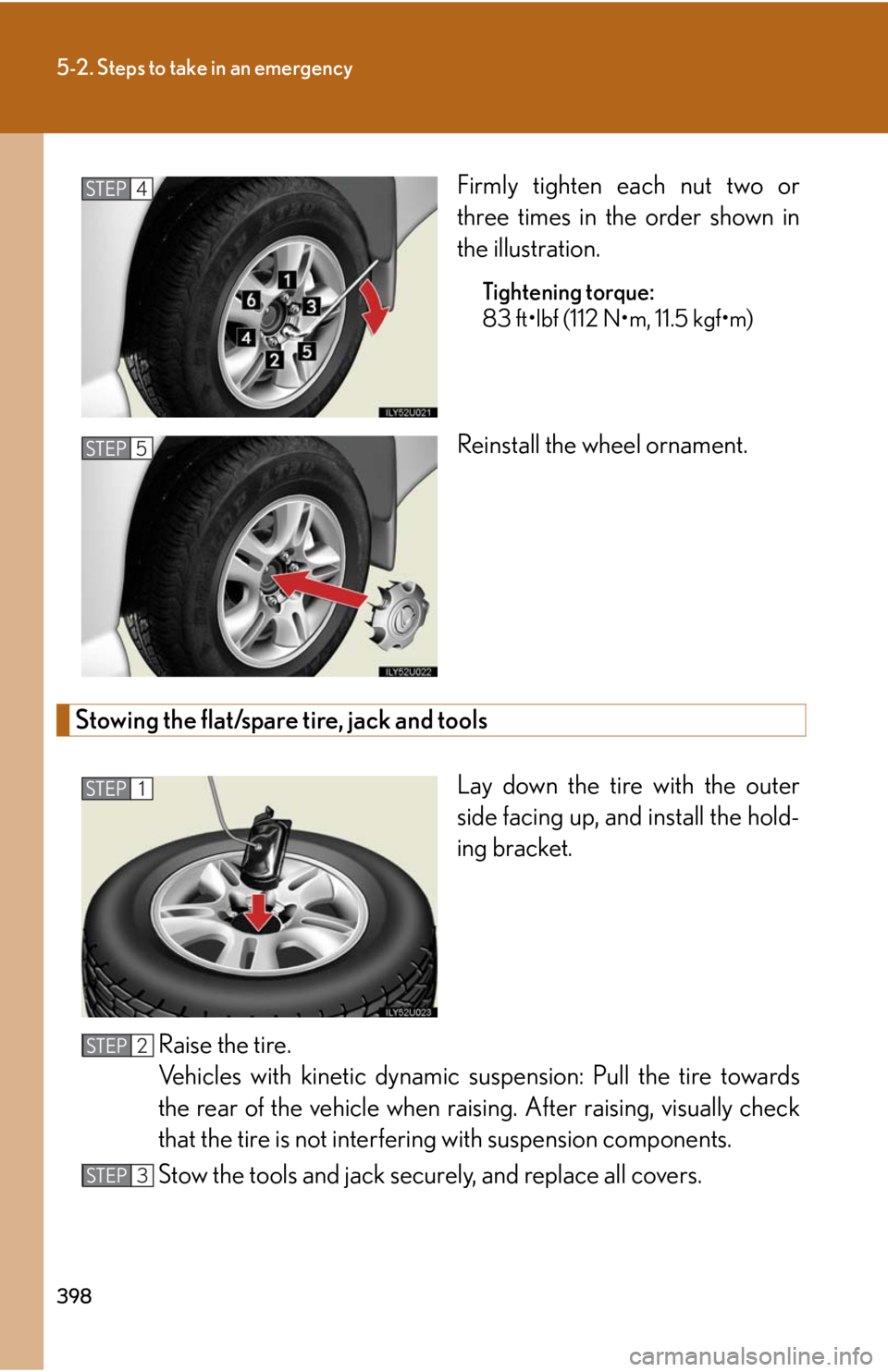
398
5-2. Steps to take in an emergency
Firmly tighten each nut two or
three times in the order shown in
the illustration.
Tightening torque:
83 ft•lbf (112 N•m, 11.5 kgf•m)
Reinstall the wheel ornament.
Stowing the flat/spare tire, jack and toolsLay down the tire with the outer
side facing up, and install the hold-
ing bracket.
Raise the tire.
Vehicles with kinetic dynamic su spension: Pull the tire towards
the rear of the vehicle when raising. After raising, visually check
that the tire is not interfering with suspension components.
Stow the tools and jack securely, and replace all covers.
STEP4
STEP5
STEP1
STEP5STEP2
STEP5STEP3
Page 401 of 458
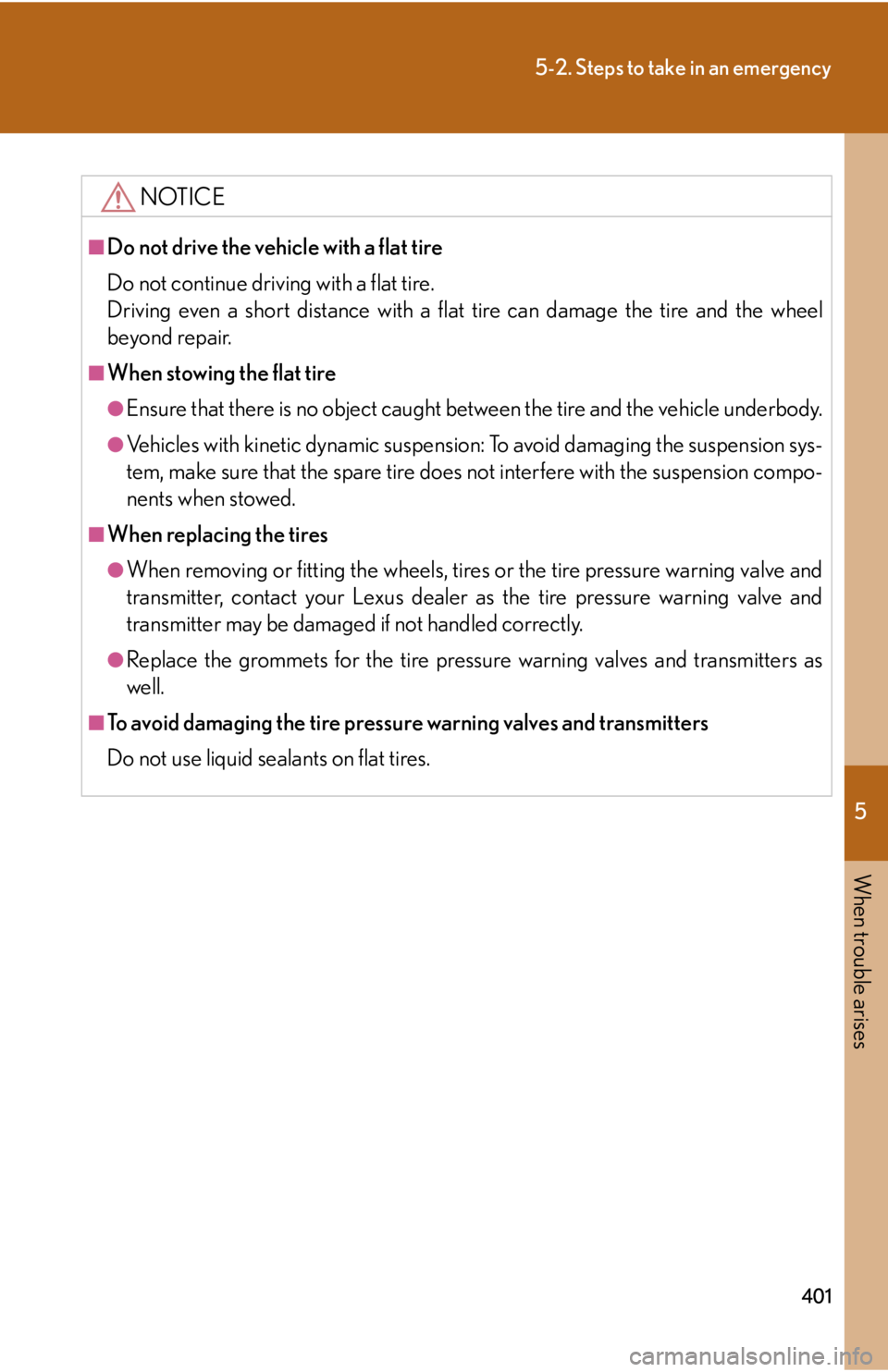
5
When trouble arises
401
5-2. Steps to take in an emergency
NOTICE
■Do not drive the vehicle with a flat tire
Do not continue driving with a flat tire.
Driving even a short distance with a flat tire can damage the tire and the wheel
beyond repair.
■When stowing the flat tire
●Ensure that there is no object caught between the tire and the vehicle underbody.
●Vehicles with kinetic dynamic suspension : To avoid damaging the suspension sys-
tem, make sure that the spare tire does not interfere with the suspension compo-
nents when stowed.
■When replacing the tires
●When removing or fitting the wheels, tires or the tire pressure warning valve and
transmitter, contact your Lexus dealer as the tire pressure warning valve and
transmitter may be damaged if not handled correctly.
●Replace the grommets for the tire pressure warning valves and transmitters as
well.
■To avoid damaging the tire pressu re warning valves and transmitters
Do not use liquid sealants on flat tires.
Page 410 of 458
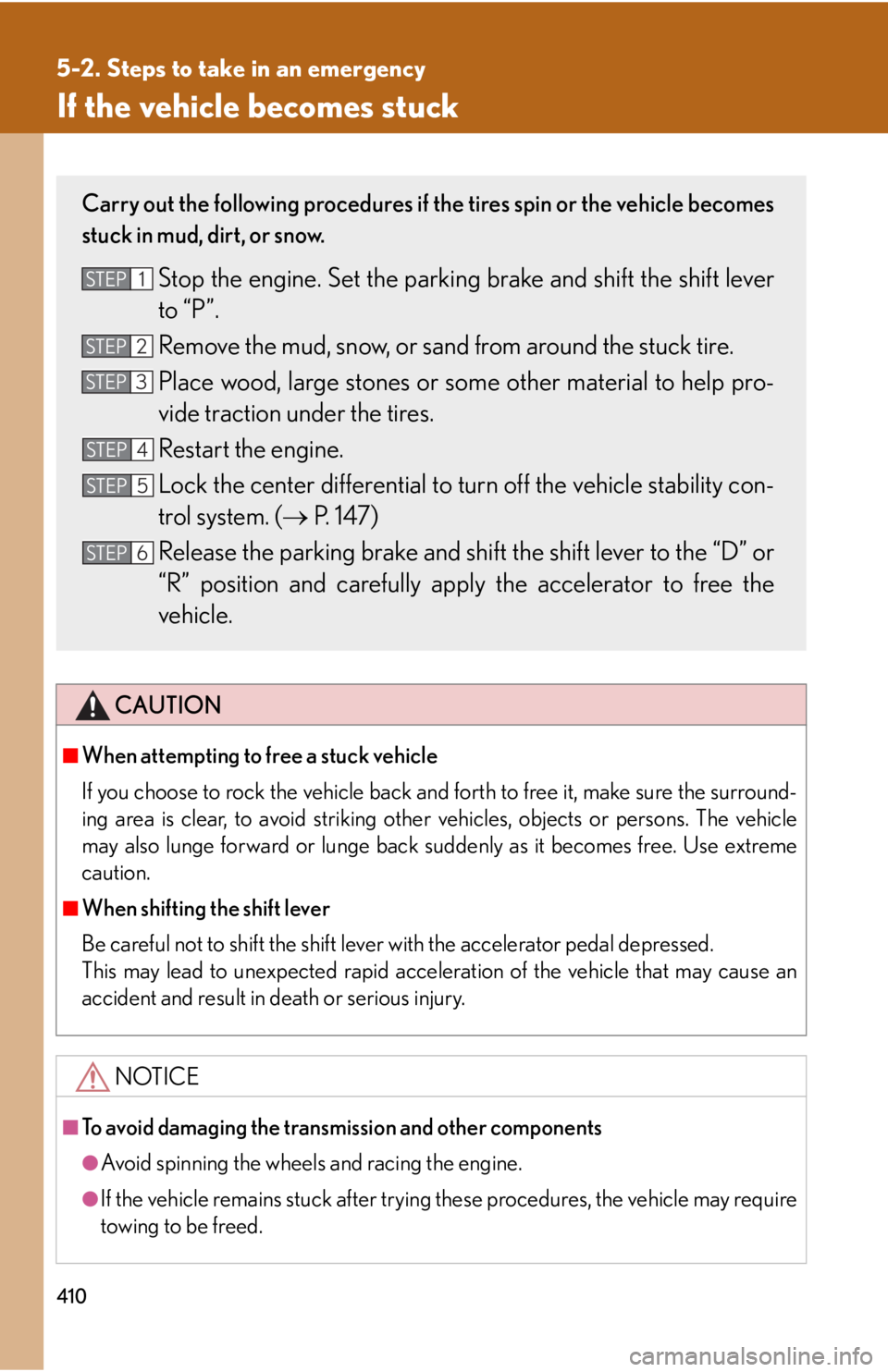
410
5-2. Steps to take in an emergency
If the vehicle becomes stuck
CAUTION
■When attempting to free a stuck vehicle
If you choose to rock the vehicle back and forth to free it, make sure the surround-
ing area is clear, to avoid striking other vehicles, objects or persons. The vehicle
may also lunge forward or lunge back suddenly as it becomes free. Use extreme
caution.
■When shifting the shift lever
Be careful not to shift the shift lever with the accelerator pedal depressed.
This may lead to unexpected rapid acceleration of the vehicle that may cause an
accident and result in death or serious injury.
NOTICE
■To avoid damaging the transmission and other components
●Avoid spinning the wheels and racing the engine.
●If the vehicle remains stuck after trying these procedures, the vehicle may require
towing to be freed.
Carry out the following procedures if the tires spin or the vehicle becomes
stuck in mud, dirt, or snow.
Stop the engine. Set the parking brake and shift the shift lever
to “P”.
Remove the mud, snow, or sand from around the stuck tire.
Place wood, large stones or so me other material to help pro-
vide traction under the tires.
Restart the engine.
Lock the center differential to turn off the vehicle stability con-
trol system. ( P. 147)
Release the parking brake and shif t the shift lever to the “D” or
“R” position and carefully apply the accelerator to free the
vehicle.STEP1
STEP2
STEP3
STEP4
STEP5
STEP6
Page 412 of 458

412
6-1. Specifications
Maintenance data (fuel, oil level, etc.)
Dimensions and weight
*1: Unladen vehicle
*2: Without roof luggage carrier
*3: With roof luggage carrier
Overall length188.2 in. (4780 mm)
Overall width74.0 in. (1880 mm)
Overall height *173.0 in. (1855 mm) *2
74.6 in. (1895 mm)*3
Wheelbase109.8 in. (2790 mm)
Tr e a dFront62.4 in. (1585 mm)
Rear62.4 in. (1585 mm)
Vehicle capacity weight
(Occupants + luggage)
With third seat
Without third seat1200 lb. (544 kg)
1000 lb. (454 kg)
Towing capacity6500 lb. (2948 kg)